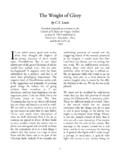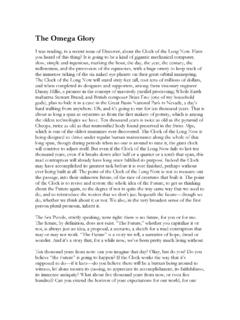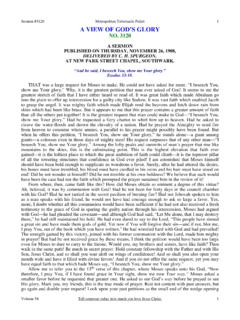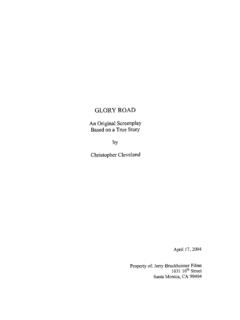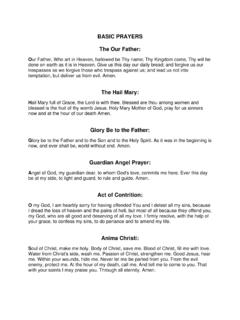Transcription of SRI NAMMAZHWAR - azhwar.org | Dr. Ranganathan
1 1 SRI NAMMAZHWAR The Vedas and the Upanishads are the ultimate source of all our spiritual and philosophical knowledge. They describe in great detail the nature of the Parabrahma, the Jeevatma, the relationship between the Jeeva and the Parabrahma, and the ultimate goal of human life that is to attain the lotus feet of the Lord. But reading and absorbing the tatva of the Upanishads is given only to great scholars. The Brahmasutras and Bhagavad Geetha attempt to present the Upanishads in a nutshell. Sri Bhashyam and Geetha Bhashyam of Sri Ramanuja simplify the Brahma Sutras and the Geetha.
2 But even these works are beyond the capacity of ordinary mortals like us who do not have scholarship in Sanskrit. The Nalayira Divya Prabandham of the Azhwars present the jnana of all these hallowed works of our tradition in Tamil in a melodious, inspired and easy to assimilate form. They are the combined works of the twelve Azhwars, but tradition has it that all these works were brought back to us through NAMMAZHWAR who appeared before Nathamuni to recite all the Nalayiram for him to compile. Hence he is hailed as "Evtmf tmizf ecyft mab[f cdEkap[f " meaning "he who presented the substance of the Vedas in Tamil" and "nat{kfK nalayirmf uArtft pira[f " meaning "he who sang the 4000 Divya Prabhandams in praise of the Lord".]]]}
3 NAMMAZHWAR was born in Thirukurugur immediately after the birth of kaliyuga. Historically he is placed at 8th century Thirukurugur is called as "Azhwar Thiru Nagari" to mark his Avathara there. It is said that Lord Krishna promised to send great mahatmas to the world to spread the name of the Lord and to propagate bhakthi in the kaliyuga, referring to the avathara of the Azhwars. NAMMAZHWAR is believed to be the amsa of Visvaksena (the Commander-in-Chief of the Lord's army). His birth took place on the very auspicious poornima day of the Tamil Vaikasi month in Visakha Nakshatram.
4 His parents were great bhakthas (Kari and Udaya Nangai) who were childless for a long time. They had gone on a pilgrimage of temples in North India and on their way back they prayed to the Lord of Thirukurungudi to bless them with a child. The Azhwar was born soon after by the divine grace of Thirukurungudi Nambi and was named "Maran" by his parents. The Azhwar proudly proclaims all these details of his parentage, his native village etc. in all his verses. Right at birth, the parents noticed that the child was unusual in many ways. He refused to take milk, did not respond to the people around but continued to live without any sustenance.
5 The parents, concerned to see this, took the child to the temple and left him in a cradle under a tamarind tree and watched with great astonishment, the divine child growing and thriving in the same place. He continued to sit there in padmasana, in divine contemplation for sixteen years. His presence enfolded the whole village in a state of divine bliss. 2 The Azhwar gives details about his life in various verses. He mentions that Lord Krishna was food and water and everything necessary to him. "u]f}WfEcaB pRK nIrf ti[f{mf evbfbiAl 'lflamf k]f][f " (Thiruvaimozhi 6-7-1) He goes on to say that he played with Lord, meditated at His holy feet, he had no interest in pleasures of the senses and he could not tolerate mundane life and that is why he kept his eyes closed.
6 "k]fD EkdfDbfB EmanfT]fDzLmf _gfkRvi k]fdvi[fpmf etrivriy `qvilflacf cibfbi[fpmf o]fedaFyaqf tiRmkQmf nIy<Em ulanibfp k]fd ctirf k]fedazinfEt[f `AdnfEt[f u[f tiRvFAy " (Thiruvaimozhi 4-9-10) His mind dwelt on the Lord all the time. "ozivilf kalemlflamf ud yf m[f[i " (Thiruvaimozhi 3-3-1) He was a staunch Srivaishnavaite who could not bear to think of other Devatas. "u[f[itfT mbfebaR etyfvmf etazalf `vA[ylflalf " (Thiruvaimozhi 4-6-10) He saw Sriman Narayana in everything and in all people around him. "tiRv<Ad m[f[Arkf ka]ilf tiRmaAl k]fEdE[ '[fBmf uRv<Ad v]f]gfkqf ka]ilf ulkqnftaE[ '[fB TqfQmf kRv<Ad Etvilfkqf 'lflamf kdlf v]f][f EkaviEl '[fBmf "(Thiruvaimozhi 4-4-8) He mentions that his jnana and bhakti were not the result of any sadhana.]]]]]
7 They came naturally to him with the grace of the Lord. "mybfvb mtinlmf `Rqi[[f " (Thiruvaimozhi 1-1-1) "'[kfEk `Rqfkqf ecyfy viti Vzfnfttalf '[kfEklmfma[f " (Thiruvaimozhi 2-7-6) "`biyakf kaltfTqfEq `FAmkfk]f `[fp< ecyfvitfT " (Thiruvaimozhi 2-3-3) Around this time, there lived another great mahatma called "Madhurakavi" who had gone on a pilgrimage to Ayodhya and other places in North India. He noticed a great flame shining constantly down south for two to three nights and was drawn towards it. Following the flame, he reached the Thirukurugur temple and saw the Azhwar seated there. To test him, he threw a small pebble before him and the divine boy woke up out of his trance for the first time.]]]]]
8 Madurakavi posed a philosophical question to the boy who answered it effortlessly. The question runs like 3 this- "ectftT vyibfbilf cibiyT pibnftalf 'tfAt ti[fB 'gfEk kidkfKmf?" This means that if the Jeeva (life which is eternal) is born into the body, which is lifeless, what will it experience and where will it live? The young saint answered "`tfAt ti[fB `gfEk kidkfKmf ". This means that if the Jeeva is a realized soul, it will contemplate on the Paramatma and will live in this divine consciousness. If not, it will endure the fruits of good and bad Karma that results from its actions born out of sensory perceptions and will remain caught in the cycle of births and deaths.]]
9 On hearing this short, yet precise answer to his intricate question, Madhurakavi recognized the mahatma before him and took refuge at his feet. Once NAMMAZHWAR woke up from his trance, he started singing his verses on the Lord. Madhurakavi recorded all the Azhwar's songs. It is believed that the Azhwar lived on the earth in the same place for 32 years. Madhurakavi composed the very beautiful "k]f]iN[f ciBtftamfp< (Kanninun Chiru Thambu)" in praise of NAMMAZHWAR . The verses are extolled by all for their beauty, melody and guru bhakthi. The works of NAMMAZHWAR , which form part of Nalayira Divya Prabhandham, are "tiRviRtftmf (Thiruviruttam - 100 verses)", "tiRvaciriymf (Thiruvasiriyam - 7 verses), "epriy tiRvnftati (Periya Thiruvandhadhi - 87 verses) and "tiRvayfemazi (Thiruvaimozhi - 1102 verses)".
10 They are believed to be the substance of the four Vedas in that order. In Thiruvirutham, the Azhwar maintains that he finds mundane life in this world unbearable. In Thiruvasiriyam, he describes and enjoys the beauty of the Lord. In Periya Thiruvandhadhi, he cries out to the Lord to take him in his fold. In Thiruvaimozhi, he enjoys the Lord, tells us the way towards Him and concludes with his "Moksha Anubhavam". The Azhwar mentions in the first Thiruvaimozhi that he needs a full thousand verses to sing the glory of the Lord. "pr[F Emlf KRPrfcf cdEkap[f ecalf nir[iAb ~yirtfT ;Av ptfTmf vIEd" (Thiruvaimozhi 1-1-11) The Lord decided to fulfill this desire.]]]



